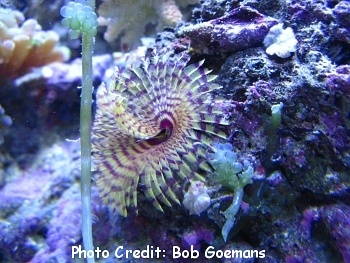
By Bob Goemans

Likely Reef Tank Suitable
Likely Fish-Only Tank Suitable
Range: Indo-West Pacific Ocean
Natural Environment: Inhabits suspension-rich lagoon, bay or back-water areas receiving gentle water movement with its parchment-like tube either embedded in shady sandy areas or attached to small rocks/rubble.
General Husbandry: Occasionally seen in the home aquarium trade.
Sabellid worms, commonly called Feather Dusters, construct a leathery tube, sometimes up to 10 inches (25 cm) in length, from which they extend a single crown of multicolored feather-like filaments (usually a mottled reddish-brown and white) of about 2 - 4 inches (5 - 10 cm) in diameter.
The identification of this species required much research since a look-a-like species exists. It was first necessary to identify the alga first seen on the rock it was attached to, which is not seen in this older photo of it. It was identified as Cladocephalus scoparius, which only grows in the Indo-Pacific. If it had been C. luteofuscus, the feather duster would have been a species from the Caribbean!
There are three species in this family that generally make it into the trade, the commonly seen S. indica (now technically listed as S. spectabilis) from the Tropical Indo-Pacific and Red Sea and S. magnifica from the Tropical West Atlantic and Caribbean, and the above mentioned species, which is infrequently seen in the trade. This is the smallest of the three, having a crown of feathers about 2 - 3 inches (5 - 7.5 cm) in diameter.
Keep in mind all feather dusters are suspension feeders and that their tubes are constructed of sand, detritus, mucus, and other bits of sediment. For those two reasons they are better located near the bottom of the aquarium where this type material is more plentiful. As for the opening of their tube, it does not have a trapdoor/operculum, as do those in the Serpulidae family, e.g., Christmas tree/Co-Co Worms. This species secretes mucus around the inner edge of the tube opening and when it retreats inward, the edges of the tube opening are pinched together/glued together, thereby preventing predators or detritus from entering.
Slime-coated filaments/tentacles are used for respiration and to collect suspended particulate matter/plankton, which is then drawn towards the central mouth. Frequent feedings, at least every other day, with fresh or preserved zooplankton (rotifers/Cyclop-eeze) and phytoplankton additives are a must for long term survival. Keep in mind that dispensing the feeding solution above the animal may cause the animal to retract with most of the solution going to waste, therefore, they should be applied near and under the crown of feathers so it can normally be drawn up and to the beating cilia on the feathers. In fact, these tiny hair-like extensions actually generate the current that draws the food supply into the feather-like head of this animal.
Feather dusters may lose their crown of 'feathers' for many reasons, e.g., poor water quality; being disturbed too often; or, lack of sufficient nutrition. This does not mean they are dead, as some will grow their feathers back in a month or two. If the head/crown of feathers returns and is smaller, this is an indication the food supply is inadequate. Could be if this happens again and the head comes back again smaller, the tubeworm will die. Always wait a couple of months and if no reappearance occurs, feel the tube with your fingers for the worm body inside. If there is some movement inside the tube, put it back and be patient for another month.
Taxonomy:
Kingdom: Animalia
Phylum: Annelida
Class: Polychaeta
Order: Sabellida
Family: Sabellidae
Genus: Sabellastarte
FYI: When it comes to keeping any of these ornamental worms, predators like triggerfishes, wrasses, angelfishes, most shrimp, and the arrow crab will not make suitable tankmates.
Experience Level: Intermediate
Diet: Filter feeder
Aquarium Environment: Reef or fish-only aquarium
Coral Safe: Yes
Fish Safe: Yes
Invertebrate Safe: Yes
Acclimation Time: >15 minutes.
Aquarium Hardiness: Moderate
Temperature Range: 72 - 83°F (22 - 28°C)
Minimum Tank Size: 50 gallons
Lighting: PAR ratings N/A
Water Movement: WM 1 - 2
Specific Gravity: 1.023 - 1.025
pH: 8.0 - 8.4
